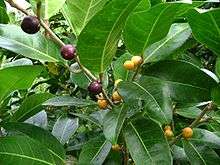Ficus tinctoria
| Dye fig | |
|---|---|
 | |
| Scientific classification | |
| Kingdom: | Plantae |
| (unranked): | Angiosperms |
| (unranked): | Eudicots |
| (unranked): | Rosids |
| Order: | Rosales |
| Family: | Moraceae |
| Genus: | Ficus |
| Species: | F. tinctoria |
| Binomial name | |
| Ficus tinctoria | |
| Synonyms[1] | |
|
List
| |
| Dye fig | |
|---|---|
| Scientific classification | |
| Kingdom: | Plantae |
| (unranked): | Angiosperms |
| (unranked): | Eudicots |
| (unranked): | Rosids |
| Order: | Rosales |
| Family: | Moraceae |
| Genus: | Ficus |
| Species: | F. tinctoria |
| Subspecies: | F. tinctoria subsp. gibbosa |
| Trinomial name | |
| Ficus tinctoria subsp. gibbosa (Blume) Corner | |
| Synonyms[2] | |
|
List
| |
Ficus tinctoria, also known as dye fig, or humped fig is a hemiepiphytic tree of genus Ficus. It is also one of the species known as strangler fig.[3]
It is found in Asia, Malesia, northern Australia, and the South Pacific islands.[3]
In Australia it is recorded as a medium-sized tree with smooth, oval green leaves.[3] It is found often growing in rocky areas or over boulders.[3] The leaves are asymmetrical.[4]
The small rust brown fruit of the dye fig are the source of a red dye used in traditional fabric making in parts of Oceania and Indonesia.
The fruit is also used for medicinal purposes.
Subspecies
Ficus tinctoria subsp. gibbosa is an accepted subspecies.[2]
References
- ↑ "The Plant List: F. tinctoria". Retrieved 22 April 2018.
- 1 2 "The Plant List: F. tinctoria subsp. gibbosa". Retrieved 22 April 2018.
- 1 2 3 4 Hyland, B. P. M.; Whiffin, T.; Zich, F. A.; et al. (Dec 2010). "Factsheet – Ficus tinctoria". Australian Tropical Rainforest Plants. Edition 6.1, online version [RFK 6.1]. Cairns, Australia: Commonwealth Scientific and Industrial Research Organisation (CSIRO), through its Division of Plant Industry; the Centre for Australian National Biodiversity Research; the Australian Tropical Herbarium, James Cook University. Retrieved 16 Mar 2013.
- ↑ Janet Franklin; Gunnar Keppel; W. Arthur Whistler (2008). "The vegetation and flora of Lakeba, Nayau and Aiwa Islands, Central Lau Group, Fiji" (PDF). Micronesica. 40: 169–225. Archived from the original (PDF) on 2012-02-13.
External links
| Wikimedia Commons has media related to Ficus tinctoria. |
This article is issued from
Wikipedia.
The text is licensed under Creative Commons - Attribution - Sharealike.
Additional terms may apply for the media files.